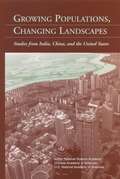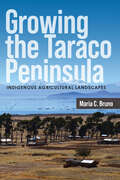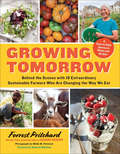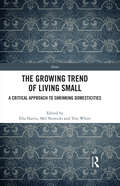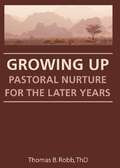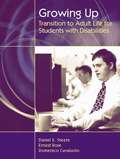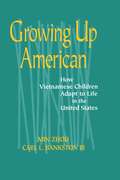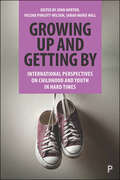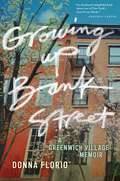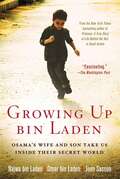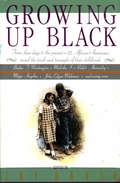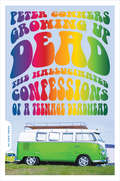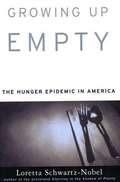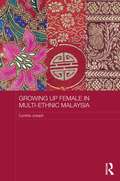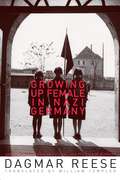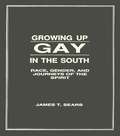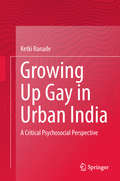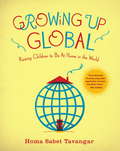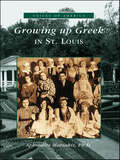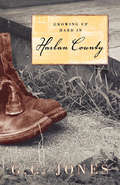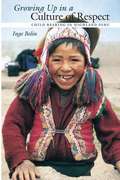- Table View
- List View
GROWING POPULATIONS, CHANGING LANDSCAPES: Studies from India, China, and the United States
by Indian National Science AcademyAs the world’s population exceeds an incredible 6 billion people, governments—and scientists—everywhere are concerned about the prospects for sustainable development. The science academies of the three most populous countries have joined forces in an unprecedented effort to understand the linkage between population growth and land-use change, and its implications for the future. By examining six sites ranging from agricultural to intensely urban to areas in transition, the multinational study panel asks how population growth and consumption directly cause land-use change, and explore the general nature of the forces driving the transformations. Growing Populations, Changing Landscapes explains how disparate government policies with unintended consequences and globalization effects that link local land-use changes to consumption patterns and labor policies in distant countries can be far more influential than simple numerical population increases. Recognizing the importance of these linkages can be a significant step toward more effective environmental management.
Growing the Taraco Peninsula: Indigenous Agricultural Landscapes
by Maria C. BrunoGrowing the Taraco Peninsula is an examination of long-term human-environmental interactions through agriculture among Indigenous communities of the Taraco Peninsula, Bolivia, located on the shores of Lake Titicaca in the Andes. Maria Bruno weaves together ethnographic observations of modern-day Aymara farming practices with an in-depth study of archaeological remains, particularly plants, to examine the development of agricultural landscapes through time. Beginning with the first small-scale communities of the Formative period (1500 BCE–500 CE) through the development of the Tiwanaku state (500–1100 CE), Bruno draws upon ethnographic insights from modern-day Indigenous farming practices on the peninsula as well as archaeological evidence from excavations at four sites to explore the landscapes and human-plant relationships that Taraco communities created through their agricultural practices. Through evaluation of environmental data on climate and land-use dynamics—rainfall, lake level, and soil character and distribution—she proposes a new hypothesis of how raised-field agriculture may have emerged in the region. With a detailed analysis of foodways at the Kala Uyuni site, her study reveals how Indigenous Taraco communities sustainably incorporated crops and wild plants into their daily and special-occasion meals, connecting the agricultural landscapes to local and regional social and political dynamics. Bringing together several indicators of the region’s long-term history and demonstrating that shifts in agriculture do not neatly correspond to the changes traditionally highlighted by archaeological culture histories, Growing the Taraco Peninsula reveals Indigenous landscape creation through farming on the Taraco peninsula as a critical example of sustainability. This valuable contribution to Andean archaeology is also of interest to scholars, students, and the general reader concerned about the environment, sustainable farming, sustainability, Andean history, and the Indigenous peoples of the Americas.
Growing Tomorrow: A Farm-to-Table Journey in Photos and Recipes: Behind the Scenes with 18 Extraordinary Sustainable Farmers Who Are Changing the Way We Eat
by Deborah Madison Forrest Pritchard Molly M. PetersonMeet the local farmers who feed America—in stories, photos, and 50 recipes! When Forrest Pritchard went looking for the unsung heroes of local, sustainable food, he found them at 18 exceptional farms all over the country. In Detroit, Aba Ifeoma of D-Town Farm dreams of replenishing the local “food desert” with organic produce. On Cape Cod, Nick Muto stays afloat and eco-friendly by fishing with the seasons. And in Washington State, fourth-generation farmer Robert Hayton confides, “This farm has been rescued by big harvests. . . . For every one great season, though, you’ve got ten years of tough.” With more than 50 mouthwatering recipes and over 250 photographs, this unique cookbook captures the struggles and triumphs of the visionary farmers who are Growing Tomorrow.
The Growing Trend of Living Small: A Critical Approach to Shrinking Domesticities (Home)
by Ella Harris Mel Nowicki Tim WhiteThis book examines the growing trend for housing models that shrink private living space and seeks to understand the implications of these shrinking domestic worlds. Small spaces have become big business. Reducing the size of our homes, and the amount of stuff within them, is increasingly sold as a catch-all solution to the stresses of modern life and the need to reduce our carbon footprint. Shrinking living space is being repackaged in a neoliberal capitalist context as a lifestyle choice rather than the consequence of diminishing choice in the face of what has become a long-term housing ‘crisis’. What does this mean for how we live in the long term, and is there a dark side to the promise of a simpler, more sustainable home life? Shrinking Domesticities brings together research from across the social sciences, planning and architecture to explore these issues. From co-living developments to the Tiny House Movement, self-storage units to practices of ‘de-stuffification’, and drawing on examples from across Europe, North America and Australasia, the authors of this volume seek to understand both what micro-living is bringing to our societies, and what it may be eroding
Growing Up: Pastoral Nurture for the Later Years
by William M Clements Thomas B RobbGrowing Up: Pastoral Nurture for the Later Years is a sensitive volume devoted to helping older adults retain their status as meaningful members of their congregations and communities. In an honest approach, based on the foundations that old age is supposed to happen, the future belongs to the old, and vocation for people of faith is lifelong, Thomas Robb provides personal and Biblical perspectives, as well as research from over 20 years as a pastor, on the life process and the feelings, worries, and expectations accompanying growing up and growing old. He then molds these concerns into a challenge for congregations and their spiritual leaders to actively assist the aged in coping with and overcoming fears and barriers limiting the fullest expression of faith in God. This insightful book describes the tasks and suggests programs for pastors and congregations everywhere in meeting the challenge, making life for the aged more than shuffleboard and bingo, pot-luck dinners and day trips. Dimensions of pastoral ministries that nurture women and men who, at midlife and beyond, seek to find their way through the unexpected and unplanned, through the third of life following parenthood and careers, are described in detail. Pastors, church leaders, congregations, professors of courses in ministry and aging, aging church members, and seminary students will benefit immensely from the wealth of information presented in Growing Up: Pastoral Nurture for the Later Years.
Growing Up: Transition to Adult Life for Students with Disabilities
by Daniel E. Steere Ernest Rose Domenico CavaiuoloCase studies of students with mild and severe disabilities are followed throughout the book to illustrate effective practices that are described. Through case studies and clearly presented content, this book helps readers learn what they can do to assist students with disabilities in achieving positive adult outcomes.
Growing Up American: How Vietnamese Children Adapt to Life in the United States
by Carl Bankston Min ZhouVietnamese Americans form a unique segment of the new U.S. immigrant population. Uprooted from their homeland and often thrust into poor urban neighborhoods, these newcomers have nevertheless managed to establish strong communities in a short space of time. Most remarkably, their children often perform at high academic levels despite difficult circumstances. Growing Up American tells the story of Vietnamese children and sheds light on how they are negotiating the difficult passage into American society. Min Zhou and Carl Bankston draw on research and insights from many sources, including the U.S. census, survey data, and their own observations and in-depth interviews. Focusing on the Versailles Village enclave in New Orleans, one of many newly established Vietnamese communities in the United States, the authors examine the complex skein of family, community, and school influences that shape these children's lives. With no ties to existing ethnic communities, Vietnamese refugees had little control over where they were settled and no economic or social networks to plug into. Growing Up American describes the process of building communities that were not simply transplants but distinctive outgrowths of the environment in which the Vietnamese found themselves. Family and social organizations re-formed in new ways, blending economic necessity with cultural tradition. These reconstructed communities create a particular form of social capital that helps disadvantaged families overcome the problems associated with poverty and ghettoization. Outside these enclaves, Vietnamese children faced a daunting school experience due to language difficulties, racial inequality, deteriorating educational services, and exposure to an often adversarial youth subculture. How have the children of Vietnamese refugees managed to overcome these challenges? Growing Up American offers important evidence that community solidarity, cultural values, and a refugee sensibility have provided them with the resources needed to get ahead in American society. Zhou and Bankston also document the price exacted by the process of adaptation, as the struggle to define a personal identity and to decide what it means to be American sometimes leads children into conflict with their tight-knit communities. Growing Up American is the first comprehensive study of the unique experiences of Vietnamese immigrant children. It sets the agenda for future research on second generation immigrants and their entry into American society.
Growing Up and Getting By: International Perspectives on Childhood and Youth in Hard Times
by John Horton, Helena Pimlott-Wilson and Sarah Marie HallBringing together new, multidisciplinary research, this book explores how children and young people across Europe, Asia, Africa and the Americas experience and cope with situations of poverty and precarity. It looks at the impact of neoliberalism, austerity and global economic crisis, evidencing the multiple harms and inequalities caused. It also examines the different ways that children, young people and families ‘get by’ under these challenging circumstances, showing how they care for one another and envisage more hopeful socio-political futures.
Growing Up Asian American in Young Adult Fiction (Children's Literature Association Series)
by Ymitri MathisonWinner of the Children’s Literature Association’s 2020 Edited Book AwardContributions by Hena Ahmad, Linda Pierce Allen, Mary J. Henderson Couzelis, Sarah Park Dahlen, Lan Dong, Tomo Hattori, Jennifer Ho, Ymitri Mathison, Leah Milne, Joy Takako Taylor, and Traise Yamamoto Often referred to as the model minority, Asian American children and adolescents feel pressured to perform academically and be disinterested in sports, with the exception of martial arts. Boys are often stereotyped as physically unattractive nerds and girls as petite and beautiful. Many Americans remain unaware of the diversity of ethnicities and races the term Asian American comprises, with Asian American adolescents proving to be more invisible than adults. As a result, Asian American adolescents are continually searching for their identity and own place in American society. For these kids, being or considered to be American becomes a challenge in itself as they assert their Asian and American identities; claim their own ethnic identity, be they immigrant or American-born; and negotiate their ethnic communities. The contributors to Growing Up Asian American in Young Adult Fiction focus on moving beyond stereotypes to examine how Asian American children and adolescents define their unique identities. Chapters focus on primary texts from many ethnicities, such as Chinese, Korean, Filipino, Japanese, Vietnamese, South Asian, and Hawaiian. Individual chapters, crossing cultural, linguistic, and racial boundaries, negotiate the complex terrain of Asian American children’s and teenagers’ identities. Chapters cover such topics as internalized racism and self-loathing; hypersexualization of Asian American females in graphic novels; interracial friendships; transnational adoptions and birth searches; food as a means of assimilation and resistance; commodity racism and the tourist gaze; the hostile and alienating environment generated by the War on Terror; and many other topics.
Growing Up Bank Street: A Greenwich Village Memoir (Washington Mews Books)
by Donna FlorioA vivid memoir of life in one of New York City’s most dynamic neighborhoodsGrowing Up Bank Street is an evocative, tender account of life in Greenwich Village, on a unique street that offered warmth, support, and inspiration to an adventurous and openhearted young girl. Bank Street, a short strip of elegant brownstones and humble tenements in Greenwich Village, can trace its lineage back to the yellow fever epidemics of colonial New York. In the middle of the last century, it became home to a cast of extraordinary characters whose stories intertwine in this spirited narrative. Growing up, Donna Florio had flamboyant, opera performer parents and even more free-spirited neighbors. As a child, she lived among beatniks, artists, rock musicians, social visionaries, movie stars, and gritty blue-collar workers, who imparted to her their irrepressibly eccentric life rules. The real-life Auntie Mame taught her that she is a divine flame from the universe. John Lennon, who lived down the street, was gracious when she dumped water on his head. Sex Pistols star Sid Vicious lived in the apartment next door, and his heroin overdose death came as a wake-up call during her wild twenties. An elderly Broadway dancer led by brave example as Donna helped him comfort dying Villagers in the terrifying early days of AIDS, and a reclusive writer gave her a path back from the brink when, as a witness to the attacks of 9/11, her world collapsed. These vibrant vignettes weave together a colorful coming of age tale against the backdrop of a historic, iconoclastic street whose residents have been at the heart of the American story. As Greenwich Village gentrifies and the hallmarks of its colorful past disappear, Growing Up Bank Street gives the reader a captivating glimpse of the thriving culture that once filled its storied streets.
Growing Up Bin Laden: Osama's Wife and Son Take Us Inside Their Secret World
by Najwa Bin Laden Omar Bin Laden Jean SassonIn their own words, Osama bin Laden's wife and son tell the astonishing story of the man they knew—or thought they knew—before September 11, 2001. <P><p> The world knows Osama bin Laden as the most wanted terrorist of our time. But people are not born terrorists, and bin Laden has carefully guarded the details of his private life—until now, when his first wife and fourth-born son break the silence to take us inside his strange and secret world. <P><P>In spine-tingling detail, Jean Sasson tells their story of life with a man whose growing commitment to violent jihad led him to move his wives and children from an orderly life to one of extreme danger, even choosing the teenage Omar to accompany him to the mountain fortress of Tora Bora.
Growing Up Black
by Jay DavidA classic work on the African-American experience is revised for the nineties with essays reflecting the concerns of black children from the last three decades and commentary from today's sports stars, politicians, and inner-city gang members.
Growing Up Dead: The Hallucinated Confessions of a Teenage Deadhead
by Peter ConnersA colorful journey from straight-laced suburban kid to ?DeadheadOCO nomad to mid-thirties dad, against the backdrop of the late OCO80s and mid-OCO90s"
Growing Up Empty: The Hunger Epidemic in America, First Edition
by Loretta Schwartz-NobelGrowing Up Empty is a study of a hidden epidemic that still remains largely unacknowledged at the highest political levels. A call to action that will re-energize the national debate on the federal government's priorities, Growing Up Empty is advocacy journalism at its best.
Growing up Female in Multi-Ethnic Malaysia (ASAA Women in Asia Series)
by Cynthia JosephThis book provides a rich, detailed analysis of the experiences of young women growing up in post-colonial, rapidly modernizing Malaysia. It considers the impact of ethnicity, socio-economic status, and school experiences and achievement. It discusses the effects of Malaysia’s ethnic affirmative action programmes and of the country’s Islamisation. It sets out and compares the life trajectories of Malay, Indian and Chinese young women, making use of interview and questionnaire data gathered over a long period. It thereby depicts individuals’ transformations as they experience maturing into adulthood against a background of social and economic changes, and varying levels of inter-racial tension.
Growing Up Female in Nazi Germany
by Dagmar ReeseGrowing Up Female in Nazi Germany explores the world of the Bund Deutscher Mädel (BDM), the female section within the Hitler Youth that included almost all German girls aged 10 to 14. The BDM is often enveloped in myths; German girls were brought up to be the compliant handmaidens of National Socialism, their mental horizon restricted to the "three Ks" of Kinder, Küche, Kirche (children, kitchen, and church). Dagmar Reese, however, depicts another picture of life in the BDM. She explores how and in what way the National Socialists were successful in linking up with the interests of contemporary girls and young women and providing them a social life of their own. The girls in the BDM found latitude for their own development while taking on responsibilities that integrated them within the folds of the National Socialist state.
Growing Up Gay in the South: Race, Gender, and Journeys of the Spirit
by James T SearsThis groundbreaking new book weaves personal portraits of lesbian and gay Southerners with interdisciplinary commentary about the impact of culture, race, and gender on the development of sexual identity. Growing Up Gay in the South is an important book that focuses on the distinct features of Southern life. It will enrich your understanding of the unique pressures faced by gay men and lesbians in this region--the pervasiveness of fundamental religious beliefs; the acceptance of racial, gender, and class community boundaries; the importance of family name and family honor; the unbending view of appropriate childhood behaviors; and the intensity of adolescent culture.You will learn what it is like to grow up gay in the South as these Southern lesbians and gay men candidly share their attitudes and feelings about themselves, their families, their schooling, and their search for a sexual identity. These insightful biographies illustrate the diversity of persons who identify themselves as gay or lesbian and depict the range of prejudice and problems they have encountered as sexual rebels. Not just a simple compilation of “coming out” stories, this landmark volume is a human testament to the process of social questioning in the search for psychological wholeness, examining the personal and social significance of acquiring a lesbian or gay identity within the Southern culture. Growing Up Gay in the South combines intriguing personal biographies with the extensive use of scholarship from lesbian and gay studies, Southern history and literature, and educational thought and practice. These features, together with an extensive bibliography and appendices of data, make this essential reading for educators and other professionals working with gay and lesbian youth.
Growing Up Gay in Urban India: A Critical Psychosocial Perspective
by Ketki RanadeThis book explores the growing up experiences of gay and lesbian individuals within their homes, schools, neighbourhoods, among friends; and their journeys of finding themselves and their communities while living in a heterosexually constructed society. It is based on an exploratory, qualitative study with young gay and lesbian persons in two cities of Maharashtra, India and employs a life course perspective. The author has written this book from two primary loci: those of a mental health professional and activist, and a queer feminist activist. Through layered narratives and psychosocial analyses of experiences that are simultaneously attentive to subjectivities and to social and interpersonal processes, the author provides insights into the lives of children who grow up feeling ‘different’ from their siblings, peers and friends, and receive constant messages about correct ways of being and expression from their parents, teachers, friends and counsellors/doctors; the unique challenges to growing up as gay or lesbian, alongside complex processes involved in the decision of ‘coming out’; and the experience of meeting others like oneself, forming intimate, romantic relationships, bonds of friendship, political solidarity, families of choice and so on. In this book, the author employs a critical stance towards mainstream life span development studies, developmental psychology, child development and childhood studies that make universal assumptions of heteronormativity and gender binarism. This book is of interest to a wide readership, from psychologists, mental health and human rights scholars, to scholars of youth and childhood studies, gender studies, cultural studies, social work, sociology and anthropology.
Growing Up Global: The Changing Transitions to Adulthood in Developing Countries
by National Research CouncilInformation on the Changing Transition to Adulthood in Developing Countries
growing up GLOBAL: THE CHANGING TRANSITIONS TO ADULTHOOD IN DEVELOPING COUNTRIES
by National Research Council Institute of Medicine of the National AcademiesThe challenges for young people making the transition to adulthood are greater today than ever before. Globalization, with its power to reach across national boundaries and into the smallest communities, carries with it the transformative power of new markets and new technology. At the same time, globalization brings with it new ideas and lifestyles that can conflict with traditional norms and values. And while the economic benefits are potentially enormous, the actual course of globalization has not been without its critics who charge that, to date, the gains have been very unevenly distributed, generating a new set of problems associated with rising inequality and social polarization. Regardless of how the globalization debate is resolved, it is clear that as broad global forces transform the world in which the next generation will live and work, the choices that today's young people make or others make on their behalf will facilitate or constrain their success as adults. Traditional expectations regarding future employment prospects and life experiences are no longer valid. Growing Up Global examines how the transition to adulthood is changing in developing countries, and what the implications of these changes might be for those responsible for designing youth policies and programs, in particular, those affecting adolescent reproductive health. The report sets forth a framework that identifies criteria for successful transitions in the context of contemporary global changes for five key adult roles: adult worker, citizen and community participant, spouse, parent, and household manager.
Growing Up Global: Raising Children to Be At Home in the World
by Homa Sabet TavangarIn today’s increasingly interconnected world, how do we prepare our children to succeed and to become happy, informed global citizens? A mother of three, Homa Sabet Tavangar has spent her career helping governments develop globally oriented programs and advising businesses on how to thrive abroad. InGrowing Up Global, Tavangar shares with all of us her “parenting toolbox” to help give our children a vital global perspective. Whether you’re mastering a greeting in ten different languages, throwing an internationally themed birthday party, or celebrating a newfound holiday, Growing Up Global provides parents and children with a rich, exciting background for exploring and connecting with far-flung nations they may have only heard about on television. Inside you’ll discover • fun activities, games, and suggestions for movies, music, books, magazines, service activities, and websites for expanding your family’s worldview • simple explanations that will help your children grasp the diversity of world faiths • creative ways to gain geography literacy • handy lists of celebrations and customs that offer a fascinating look at how people from different cultures around the world live everyday life Growing Up Globalis a book that parents, grandparents, and teachers can turn to again and again for inspiration and motivation as they strive to open the minds of children everywhere.
Growing Up Godless: Non-Religious Childhoods in Contemporary England
by Anna Strhan Rachael ShillitoeHow children&’s non-belief and non-religion are formed in everyday lifeThe number of those identifying as &“non-religious&” has risen rapidly in Britain and many other parts of Europe and North America. Although non-religion and non-belief are especially prevalent among younger people, we know little about the experience of children who are growing up without religion. In Growing Up Godless, Anna Strhan and Rachael Shillitoe fill this scholarly gap, examining how, when, where, and with whom children in England learn to be non-religious and non-believing. Drawing on in-depth interviews and extensive ethnographic fieldwork with children, their parents, and teachers, Strhan and Shillitoe offer a pioneering account of what these children believe in and care about and how they navigate a social landscape of growing religious diversity.Moving beyond the conventional understanding of non-religion as merely the absence of religion, Strhan and Shillitoe show how children&’s non-religion and non-belief emerge in relation to a pervasive humanism—centering the agency, significance, and achievements of humans and values of equality and respect—interwoven in their homes, schools, media, and culture. Their findings offer important new insight into the rise and formation of non-religious identities and, more broadly, the ways that children&’s beliefs and values are shaped in contemporary society.
Growing Up Greek in St. Louis (Voices of America)
by Aphrodite Matsakis Ph.D.Since the beginning of the 20th century, St. Louis' Greek-American community has been a vibrant part of the city's fabric. Through a series of vivid personal accounts of growing up in two worlds during the post-WWII era, Growing Up Greek in St. Louis explores the challenges faced by Greek-Americans as they sought to preserve a rich cultural heritage while assimilating to American ways.From a detailed account of her Grandmothers' struggles during the occupation of Greece during WWII and the Asia Minor Holocaust to the first hand experiences faced by Greek-American children in Greek school, the celebration of name days, and the ever-present "evil eye," the book captures the sense of tradition, history, hospitality (philotimo), and community so vital to the Greek experience.
Growing Up Hard in Harlan County
by G. C. JonesThis classic memoir is “an absorbing tale” of life in Appalachian Kentucky during the Great Depression (The Washington Post).G.C. “Red” Jones’s classic memoir of growing up in rural eastern Kentucky during the Depression is a story of courage, persistence, and eventual triumph. His priceless and detailed recollections of hardscrabble farming, of the impact of Prohibition on an individualistic people, of the community-destroying mine wars of “Bloody Harlan,” and of the drastic dislocations brought by World War II are essential to understanding this seminal era in Appalachian history.“An absorbing tale told in the vernacular language of the teamsters, farmers and miners in rural, mountainous Kentucky in the early decades of this century. The narrative flows with the symmetry that comes naturally to the accomplished storyteller.” —TheWashington Post“Draws the reader into a sometimes frightening world of survival.” —Lexington Herald-Leader“He bears witness to Harlan County—first as a community of self-sufficient farmers, then as a mining area and finally in the 1930s as ‘bloody Harlan’ . . . Mr. Jones celebrates horses and mules, the bounty of the hillside farms and woods and the rough ingenuity, honor and sweetness of the mountain people.” —The New York Times“Jones shows all of us that fierce determination, lived day by day, can lead to a satisfying life, even though it might be hard.” —Kentucky Monthly
Growing Up in a Culture of Respect
by Inge Bolin"This is a wonderful book, a brilliant book, one that explains Andean culture in a totally unique and fascinating way. . . . Professor Bolin's truly wonderful powers of observation and her sensitivity and receptiveness to Chillihuani culture combine to provide us with a rare opportunity to see and begin to understand a beautiful people whose culture could not be more different from that of the so-called western world. "-Thomas M. Davies, Jr. , Professor Emeritus of Latin American History and Director Emeritus, Center for Latin American Studies, San Diego State University"Societal changes have consequences, and how a people choose to raise their children reveals much about their values and spirit of place. Andean children, (though living with material scarcity), are fully entwined in a network of reciprocal obligations, thereby discovering the meaning of being human. It is this culture of respect that Inge Bolin reveals in this splendid and original book. "-Wade Davis, Explorer-in-Residence, National Geographic Society, author of One River and The Serpent and the RainbowFar from the mainstream of society, the pastoral community of Chillihuani in the high Peruvian Andes rears children who are well-adjusted, creative, and curious. They exhibit superior social and cognitive skills and maintain an attitude of respect for all life as they progress smoothly from childhood to adulthood without a troubled adolescence. What makes such child-rearing success even more remarkable is that "childhood" is not recognized as a distinct phase of life. Instead, children assume adult rights and responsibilities at an early age in order to help the community survive in a rugged natural environment and utter material poverty. This beautifully written ethnography provides the first full account of child-rearing practices in the high Peruvian Andes. Inge Bolin traces children's lives from birth to adulthood and finds truly amazing strategies of child rearing, as well as impressive ways of living that allow teenagers to enjoy the adolescent stage of their lives while contributing significantly to the welfare of their families and the community. Throughout her discussion, Bolin demonstrates that traditional practices of respect, whose roots reach back to pre-Columbian times, are what enable the children of the high Andes to mature into dignified, resilient, and caring adults.
